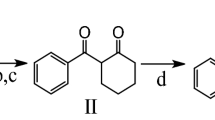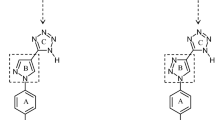Abstract
The present study assessed the 2,3-substituted-1,3-thiazolidin-4-ones antinociceptive potential looking at the acute nociception model induced by thermal stimulation in mice. This was done to contribute to the development of new analgesic drugs, in addition to the fact that 4-thiazolidinones are an important scaffold associated with many pharmacological activities. The synthesized compounds were characterized by GC-MS and NMR of 1H and 13C and administered at a dose of 100 mg/kg hydrochloride salt (ip). Sodium dipyrone (250 and 500 mg/Kg; ip) and tramadol hydrochloride (25 and 50 mg/Kg; ip) were used as positive controls. The hot plate test was done at a temperature of 50 ± 0.1 °C and animals assessed at 30, 60, and 90 min after the drugs were administered. Among the fourteen compounds tested, nine (5Aa, 5Ab, 5Ac, 5Ad, 5Ba, 5Bb, 5Bd, 5Ea, and 5Fa) showed significant increases in latency time when compared to saline (negative control) and compared to sodium dipyrone (500 mg/Kg; ip) in a 30-min assessment. The highest latency times were obtained for 3-(2-piperidin-1-yl)ethyl)thiazolidin-4-one derivatives (5Ab, 5Ac, and 5Ad). This highlights three findings about the chemical structure that improve activity: (i) an ethylenic link; (ii) a six-membered piperidine; (iii) an aliphatic substituent at the 2-position of thiazolidinone ring.




Similar content being viewed by others
References
Bjarnason I, Hayllar J, Macpherson AJ, Russell AS (1993) Side effects of nonsteroidal anti-inflammatory drugs on the small and large intestine in humans. Gastroenterology 104:1832–1847
Camu F, Vanlersberghe C (2002) Pharmacology of systemic analgesics. Best Pract Res Clin Anaesthesiol 16:475–488
Costa CA, Santos C, Alves P, Costa A (2007) Oncologic pain. Rev Port Pneumol 13:855–867
Cunico W, Gomes CRB, Vellasco Jr WT (2008) Chemistry and biological activities of 1,3-thiazolidin-4-ones. Mini-Rev Org Chem 5:336–344
Davis R, Brogden RN (1994) Nimesulide. An update of its pharmacodynamic and pharmacokinetic properties, and therapeutic efficacy. Drugs 48:431–454
Edwards J, Meseguer F, Faura C, Moore RA, McQuay HJ, Derry S (2010) Single dose dipyrone for acute postoperative pain. Cochrane Database Syst Rev Sep 8:CD003227
Geronikaki AA, Lagunin AA, Hadjipavlou-Litina DI, Eleftheriou PT, Filimonov DA, Poroikov VV, Alam I, Saxena AK (2008) Computer-aided discovery of anti-inflammatory thiazolidinones with dual cyclooxygenase/lipoxygenase inhibition. J Med Chem 51:1601–1609
Giraldes AL, Sousa AM, Slullitel A, Guimarães GM, Santos MG, Pinto RE, Ashmawi HA, Sakata RK (2016) Tramadol wound infiltration is not different from intravenous tramadol in children: a randomized controlled trial. J Clin Anesth 28:62–66
Gouvêa DP, Bareño VDO, Bosenbecker J, Drawanz BB, Neuenfeldt PD, Siqueira GM, Cunico W (2012) Ultrasonics promoted synthesis of thiazolidinones from 2-aminopyridine and 2-picolylamine. Ultrason Sonochem 19:1127–1131
Jain AK, Vaidya A, Ravichandran V, Kashaw SK, Agrawal RK (2012) Recent developments and biological activities of thiazolidinone derivatives: a review. Bioorg Med Chem 20:3378–3395
Kopf N, Patel A (2010) Guide to pain management in a low resource setting, International Association for the Study of Pain (AISP), Subcommittee on Taxonomy
Kunzler A, Neuenfeldt PD, Neves AM, Pereira CMP, Marques GH, Nascente PS, Fernandes MHV, Hübner SO, Cunico W (2013) Synthesis, antifungal and cytotoxic activities of 2-aryl-3-((piperidin-1-yl)ethyl) thiazolidinones. Eur J Med Chem 64:74–80
Kurita GP, Pimenta CAM (2003) Compliance with chronic pain treatment: study of demographic, therapeutic and psychosocial variables. Arq Neuropsiquiatr 61:416–425
Liu X, Ye W, Watson P, Tepper P (2010) Use of benzodiazepines, hypnotics, and anxiolytics in major depressive disorder: association with chronic pain diseases. J Nerv Ment Dis 198:544–550
Luszczki JJ (2010) Dose-response relationship analysis of pregabalin doses and their antinociceptive effects in hot-plate test in mice. Pharmacol Rep 62:942–948
Nelson AD, Camilleri N (2015) Chronic opioid induced constipation in patients with nonmalignant pain: challenges and opportunities. Ther Adv Gastroenterol 8:206–220
Nossaman VE, Ramadhyani U, Kadowitz PJ, Nossaman BD (2010) Advances in perioperative pain management: use of medications with dual analgesic mechanisms, tramadol & tapentadol. Anesthesiol Clin 28:647–666
Prasit P, Wang Z, Brideau C, Chan C-C, Charlson S, Cromlish W, Ethier D, Evans JF, Ford-Hutchinson AW, Gauthier JY, Gordon R, Guay J, Gresser M, Kargman S, Kennedy B, Leblanc Y, Leger S, Mancini J, O’Neal GP, Quellet M, Percival MD, Perrier H, Riendeau D, Rodger I, Tagari P, Therien M, Vikers P, Wong E, Xu L-J, Young RN, Zamboni R, Boyce S, Rupniak N, Forrest M, Visco D, Patrcik D (1999) The discovery of rofecoxib, [MK 966, Vioxx, 4-(4’-methylsulfonylphenyl)-3-phenyl-2(5H)-furanone], an orally active cyclooxygenase-2-inhibitor. Bioorg Med Chem Lett 9:1773–1778
Shinde S, Gordon P, Sharma P, Gross J, Davis MP (2015) Use of non-opioid analgesics as adjuvants to opioid analgesia for cancer pain management in an inpatient palliative unit: does this improve pain control and reduce opioid requirements? Support Care Cancer 23:695–703
Siegfried B, Netto CA, Izquierdo I (1987) Exposure to novelty induces naltrexone-reversible analgesia in rats. Behav Neurosci 101:436–438
Silva AP, Moraes MW (2010) Incidence of postoperative pain after esthetic plastic surgery. Rev Dor 11:136–139
Sun Q, Kyle DJ (2003) Aryl-substituted thiazolidinones and therapeutic use thereof. WO Patent 03/008398 A1, 2003
Taranalli AD, Bhat AR, Srinivas S, Saravanan E (2008) Antiinflammatory, analgesic and antipyretic activity of certain thiazolidinones. Indian J Pharm Sci 70:159–164
Teixeira RC, Monteiro ER, Campagnol D, Coelho K, Bressan TF, Monteiro BS (2013) Effects of tramadol alone, in combination with meloxicam or dipyrone, on postoperative pain and the analgesic requirement in dogs undergoing unilateral mastectomy with or without ovariohysterectomy. Vet Anaesth Analg 40:641–649
Tripathi AV, Gupta SJ, Fatima GN, Sonar PK, Verma A, Sara SK (2014) 4-Thiazolidinones: the advances continue…. Eur J Med Chem 72:52–77
Tulunay FC, Ergün H, Gülmez SE, Ozbenli T, Ozmenoğlu M, Boz C, Erdemoglu AK, Varlikbas A, Göksan B, Inan L (2004) The efficacy and safety of dipyrone (Novalgin) tablets in the treatment of acute migraine attacks: a double-blind, cross-over, randomized, placebo-controlled, multi-center study. Funct Neurol 19:197–202
Unsal-Tan O, Ozadali K, Piskin K, Balkan A (2012) Molecular modeling, synthesis and screening of some new 4-thiazolidinone derivatives with promising selective COX-2 inhibitory activity. Eur J Med Chem 57:59–64
Verçoza GL, Feitoza DD, Alves AJ, Aquino TM, Lima JG, Araújo JM, Cunha IGB, Góes AJS (2009) Synthesis and antimicrobial activities of new 4-thiazolidones derived from formylpyridine thiosemicarbazones. Quim Nova 32:1405–1410
Vigorita MG, Ottanà R, Monforte F, Maccari R, Monforte MT, Trovato A, Taviano MF, Miceli N, De Luca G, Alcaro S, Ortuso F (2003) Chiral 3,3’-(1,2-ethanediyl)-bis[2-(3,4-dimethoxyphenyl)-4-thiazolidinones] with anti-inflammatory activity. Part 11: evaluation of COX-2 selectivity and modeling. Bioorg Med Chem 11:999–1006
Vigorita MG, Ottanà R, Monforte F, Maccari R, Trovato A, Monforte MT, Taviano MF (2001) Synthesis and antiinflammatory, analgesic activity of 3,3’-(1,2-ethanediyl)-bis(2-aryl-4-thiazolidinone) chiral compounds. Part 10. Bioorg Med Chem 11:2791–2794
Zarghi A, Najafnia L, Daraee B, Dadrass OG, Hedayati M (2007) Synthesis of 2,3-diaryl-1,3-thiazolidine-4-one derivatives as selective cyclooxygenase (COX-2) inhibitors. Bioorg Med Chem Lett 17:5634–5637
Zimmermann M (1983) Ethical guidelines for investigations of experimental pain in conscious animals. Pain 16:109–110
Acknowledgements
The authors thank UFPel and FAPERGS (proc. 11/2068-7) for financial support. Fellowships granted to A.H.S.N. by CAPES, D.S.S by CAPES/FAPERGS and W.C. by CNPq (proc. 308791/2015-0).
Author information
Authors and Affiliations
Corresponding authors
Ethics declarations
Conflict of interest
The authors declare that they have no competing interests.
Electronic supplementary material
Rights and permissions
About this article
Cite this article
Neves, A.H.S., da Silva, D.S., Siqueira, G.M. et al. The antinociceptive evaluation of 2,3-substituted-1,3-thiazolidin-4-ones through thermal stimulation in mice. Med Chem Res 27, 186–193 (2018). https://doi.org/10.1007/s00044-017-2052-1
Received:
Accepted:
Published:
Issue Date:
DOI: https://doi.org/10.1007/s00044-017-2052-1




